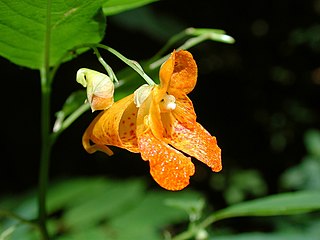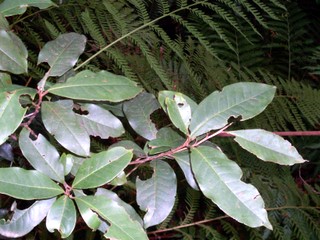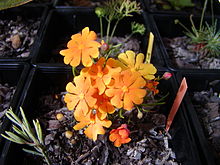
Commelinales is an order of flowering plants. It comprises five families: Commelinaceae, Haemodoraceae, Hanguanaceae, Philydraceae, and Pontederiaceae. All the families combined contain over 885 species in about 70 genera; the majority of species are in the Commelinaceae. Plants in the order share a number of synapomorphies that tie them together, such as a lack of mycorrhizal associations and tapetal raphides. Estimates differ as to when the Commelinales evolved, but most suggest an origin and diversification sometime during the mid- to late Cretaceous. Depending on the methods used, studies suggest a range of origin between 123 and 73 million years, with diversification occurring within the group 110 to 66 million years ago. The order's closest relatives are in the Zingiberales, which includes ginger, bananas, cardamom, and others.

Fabales is an order of flowering plants included in the rosid group of the eudicots in the Angiosperm Phylogeny Group II classification system. In the APG II circumscription, this order includes the families Fabaceae or legumes, Quillajaceae, Polygalaceae or milkworts, and Surianaceae. Under the Cronquist system and some other plant classification systems, the order Fabales contains only the family Fabaceae. In the classification system of Dahlgren the Fabales were in the superorder Fabiflorae with three families corresponding to the subfamilies of Fabaceae in APG II. The other families treated in the Fabales by the APG II classification were placed in separate orders by Cronquist, the Polygalaceae within its own order, the Polygalales, and the Quillajaceae and Surianaceae within the Rosales.

The Magnoliales are an order of flowering plants. Well-known members of Magnoliales include: magnolias, tulip trees, custard apples, American pawpaw, cherimoyas, ylang-ylang, soursop fruit, and nutmeg.

Sapindales is an order of flowering plants. Well-known members of Sapindales include citrus; maples, horse-chestnuts, lychees and rambutans; mangos and cashews; frankincense and myrrh; mahogany and neem.

Piperales is an order of flowering plants. It necessarily includes the family Piperaceae but other taxa have been included or disincluded variously over time. Well-known plants which may be included in this order include black pepper, kava, the many Peperomias, pepper elder, lizard's tail, birthwort, and wild ginger. The two perianthless families Piperaceae and Saururaceae are mainly herbaceous plants possessing highly reduced flowers.

Ranunculales is an order of flowering plants. Of necessity it contains the family Ranunculaceae, the buttercup family, because the name of the order is based on the name of a genus in that family. Ranunculales belongs to a paraphyletic group known as the basal eudicots. It is the most basal clade in this group; in other words, it is sister to the remaining eudicots. Widely known members include poppies, barberries, hellebores, and buttercups.

Proteales is an order of flowering plants consisting of three families. The Proteales have been recognized by almost all taxonomists.

The Buxales are a small order of eudicot flowering plants, recognized by the APG IV system of 2016. The order includes the family Buxaceae; the families Didymelaceae and Haptanthaceae may also be recognized or may be included in the Buxaceae. Many members of the order are evergreen shrubs or trees, although some are herbaceous perennials. They have separate "male" (staminate) and "female" (carpellate) flowers, mostly on the same plant. Some species are of economic importance either for the wood they produce or as ornamental plants.

The Angiosperm Phylogeny Group (APG) is an informal international group of systematic botanists who collaborate to establish a consensus on the taxonomy of flowering plants (angiosperms) that reflects new knowledge about plant relationships discovered through phylogenetic studies.

Austrobaileya is the sole genus consisting of a single species that constitutes the entire flowering plant family Austrobaileyaceae. The species Austrobaileya scandens grows naturally only in the Wet Tropics rainforests of northeastern Queensland, Australia.

Dilleniaceae is a family of flowering plants with 11 genera and about 430 known species. Such a family has been universally recognized by taxonomists. It is known to gardeners for the genus Hibbertia, which contains many commercially valuable garden species.

The eudicots, Eudicotidae, or eudicotyledons are a clade of flowering plants (angiosperms) which are mainly characterized by having two seed leaves (cotyledons) upon germination. The term derives from dicotyledon. Historically, authors have used the terms tricolpates or non-magnoliid dicots. The current botanical terms were introduced in 1991, by evolutionary botanist James A. Doyle and paleobotanist Carol L. Hotton, to emphasize the later evolutionary divergence of tricolpate dicots from earlier, less specialized, dicots.

The rosids are members of a large clade of flowering plants, containing about 70,000 species, more than a quarter of all angiosperms.

In the APG IV system (2016) for the classification of flowering plants, the name asterids denotes a clade. Asterids is the largest group of flowering plants, with more than 80,000 species, about a third of the total flowering plant species. Well-known plants in this clade include the common daisy, forget-me-nots, nightshades, the common sunflower, petunias, yacon, morning glory, lettuce, sweet potato, coffee, lavender, lilac, olive, jasmine, honeysuckle, ash tree, teak, snapdragon, sesame, psyllium, garden sage, blueberries, table herbs such as mint, basil, and rosemary, and rainforest trees such as Brazil nut.

Siparunaceae is a family of flowering plants in the magnoliid order Laurales. It consists of two genera of woody plants, with essential oils: Glossocalyx in West Africa and Siparuna in the neotropics. Glossocalyx is monospecific and Siparuna has about 74 known species.
The APG II system of plant classification is the second, now obsolete, version of a modern, mostly molecular-based, system of plant taxonomy that was published in April 2003 by the Angiosperm Phylogeny Group. It was a revision of the first APG system, published in 1998, and was superseded in 2009 by a further revision, the APG III system.

The Paracryphiaceae are a family of woody shrubs and trees native to Australia, southeast Asia, and New Caledonia. In the APG III system of 2009, the family is placed in its own order, Paracryphiales, in the campanulid clade of the asterids. In the earlier APG II system, the family was unplaced as to order and included only Paracryphia.

Huaceae is a family of plant in the rosids group, which has been classed in the orders Malpighiales, Malvales, and Violales or in its own order Huales. The APG II system placed it in the clade eurosids I, whereas the APG III system of 2009 and APG IV (2016) place it within the Oxalidales. The family is endemic to central Africa. It contains four species in the following two genera:

The superrosids are members of a large clade of flowering plants, containing more than 88,000 species, and thus more than a quarter of all angiosperms.

The superasterids are members of a large clade of flowering plants, containing more than 122,000 species.



















